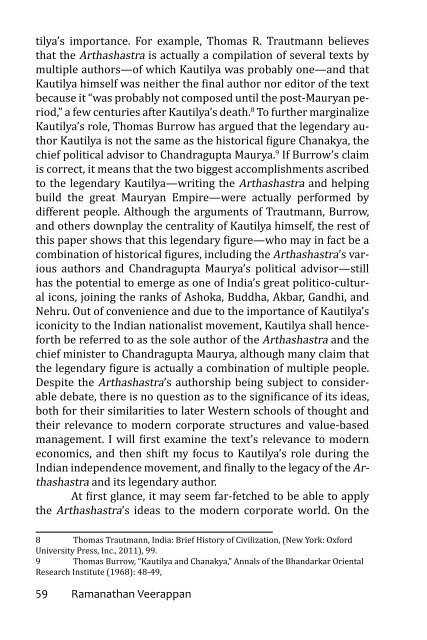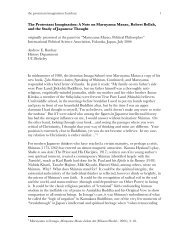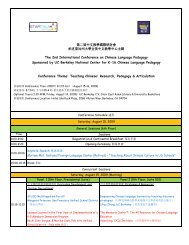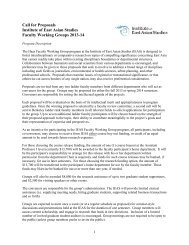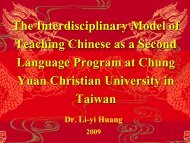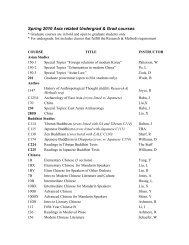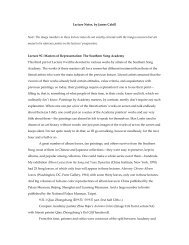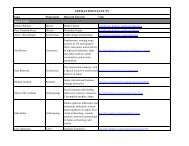Third Edition Spring 2013 - Institute of East Asian Studies, UC ...
Third Edition Spring 2013 - Institute of East Asian Studies, UC ...
Third Edition Spring 2013 - Institute of East Asian Studies, UC ...
You also want an ePaper? Increase the reach of your titles
YUMPU automatically turns print PDFs into web optimized ePapers that Google loves.
tilya’s importance. For example, Thomas R. Trautmann believesthat the Arthashastra is actually a compilation <strong>of</strong> several texts bymultiple authors—<strong>of</strong> which Kautilya was probably one—and thatKautilya himself was neither the final author nor editor <strong>of</strong> the textbecause it “was probably not composed until the post-Mauryan period,”a few centuries after Kautilya’s death. 8 To further marginalizeKautilya’s role, Thomas Burrow has argued that the legendary authorKautilya is not the same as the historical figure Chanakya, thechief political advisor to Chandragupta Maurya. 9 If Burrow’s claimis correct, it means that the two biggest accomplishments ascribedto the legendary Kautilya—writing the Arthashastra and helpingbuild the great Mauryan Empire—were actually performed bydifferent people. Although the arguments <strong>of</strong> Trautmann, Burrow,and others downplay the centrality <strong>of</strong> Kautilya himself, the rest <strong>of</strong>this paper shows that this legendary figure—who may in fact be acombination <strong>of</strong> historical figures, including the Arthashastra’s variousauthors and Chandragupta Maurya’s political advisor—stillhas the potential to emerge as one <strong>of</strong> India’s great politico-culturalicons, joining the ranks <strong>of</strong> Ashoka, Buddha, Akbar, Gandhi, andNehru. Out <strong>of</strong> convenience and due to the importance <strong>of</strong> Kautilya’siconicity to the Indian nationalist movement, Kautilya shall henceforthbe referred to as the sole author <strong>of</strong> the Arthashastra and thechief minister to Chandragupta Maurya, although many claim thatthe legendary figure is actually a combination <strong>of</strong> multiple people.Despite the Arthashastra’s authorship being subject to considerabledebate, there is no question as to the significance <strong>of</strong> its ideas,both for their similarities to later Western schools <strong>of</strong> thought andtheir relevance to modern corporate structures and value-basedmanagement. I will first examine the text’s relevance to moderneconomics, and then shift my focus to Kautilya’s role during theIndian independence movement, and finally to the legacy <strong>of</strong> the Arthashastraand its legendary author.At first glance, it may seem far-fetched to be able to applythe Arthashastra’s ideas to the modern corporate world. On the8 Thomas Trautmann, India: Brief History <strong>of</strong> Civilization, (New York: OxfordUniversity Press, Inc., 2011), 99.9 Thomas Burrow, “Kautilya and Chanakya,” Annals <strong>of</strong> the Bhandarkar OrientalResearch <strong>Institute</strong> (1968): 48-49,surface, Kautilya’s Arthashastra and its concepts <strong>of</strong> realpolitik appearmost relevant to expansionist regional states. In discussing hisideas on the ideal state, Kautilya writes from “the point <strong>of</strong> view thatkingship is the normal and desirable form <strong>of</strong> government,” whilestressing the need for a hierarchy <strong>of</strong> advisors to assist the king. 10Thus, Kautilya’s ideal state is structured along monarchical feudallines, so that the Arthashastra’s strategies seemingly apply bestto systems <strong>of</strong> this type. Kautilya outlines the structure <strong>of</strong> his idealstate in Book VI <strong>of</strong> the Arthashastra, suggesting that “The king,the minister, the country, the fort, the treasury, the army and thefriend are the (fundamental) elements <strong>of</strong> sovereignty.” 11 Similarly,Timothy W. Starzl and Krishna S. Dhir argue that a feudal systemis still to be found in modern corporate structures. They point outthe strikingly similar features that corporations share with feudalstates, such as a “head <strong>of</strong> state” in the form <strong>of</strong> a CEO, who dependsheavily on a set <strong>of</strong> “ministers”— VP’s and division heads—whocontrol different areas <strong>of</strong> the CEO’s domain in the name <strong>of</strong> their“ruler.” 12 Also important is the fact that in corporations and feudalstates alike, no individual’s position is secure. 13 The modern CEOdemands success from the firm’s employees; if an individual doesnot meet certain standards, he or she may face punishment for hisor her failures. Likewise, Kautilya also suggests that no individuals’sposition is secure, stating in Book VII <strong>of</strong> the Arthashastra:it is verily the king who attends to the business <strong>of</strong> appointing ministers,priests, and other servants, including the superintendents <strong>of</strong>several departments, the application <strong>of</strong> remedies against the troubles<strong>of</strong> his people, and <strong>of</strong> his kingdom, and the adoption <strong>of</strong> progressivemeasures; when his ministers fall into troubles, he employsothers; he is ever ready to bestow rewards on the worthy and inflictpunishments on the wicked. 1410 Thomas Trautmann, India: Brief History <strong>of</strong> Civilization, (New York: OxfordUniversity Press, Inc., 2011), 98.11 Kautilya. Arthashastra. Translated by R. Shamasastry. Bangalore: GovernmentPress, 1915, 319-325.12 Timothy Starzl, and Krishna Dhir, “Strategic Planning 2300 Years Ago: TheStrategy <strong>of</strong> Kautilya,” Management International Review, 26, no. 4 (1986): 75.13 Ibid., 7614 Kautilya. Arthashastra. Translated by R. Shamasastry. Bangalore: GovernmentPress, 1915, 391-409.59 Ramanathan Veerappan Kautilya’s Arthashastra 60


